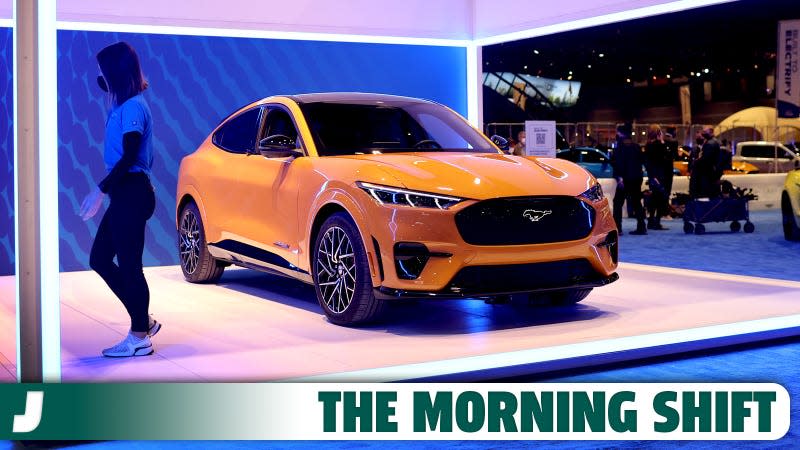Ford Is Doing Very Well So Long As You Ignore The $4.5B They Could Lose On EVs

Good morning! It’s Friday, July 28, 2023 and this is The Morning Shift, your daily roundup of the top automotive headlines from around the world, in one place. Here are the important stories you need to know.
1st Gear: It Ain’t Easy For Model e
The second quarter of 2023 was kind to the Ford Motor Company — kind enough for it to bump up its full-year earnings guidance to between $11 billion and $12 billion. That’s thanks to pricing and demand “holding up” better than Dearborn expected earlier in the year, according to CFO John Lawler. On the flip side, uptake on the brand’s EVs has been rather disappointing, and the Model e division lost $1.08 billion between April and June, per CNBC.
Read more
The state of things has caused Ford to walk back its ramp up of EV production, as the company doesn’t believe it can keep up with all those price cuts in the segment, touched off by Tesla at the start of 2023. From Bloomberg:
The automaker on Thursday said it would need another year to meet a year-end target to reach an annual production rate of 600,000 EVs, which it now expects to reach in 2024. Ford also abandoned plans to be making 2 million EVs a year by the end of 2026.
It now expects to see losses from EVs hit $4.5 billion this year, up from an earlier estimate of $3 billion. That’s more than double the $2.1 billion the company lost on EVs last year. [...]
Chief Executive Officer Jim Farley’s $50 billion bet on EVs is confronting slowing demand for plug-in models. Ford is still aiming to achieve an 8% return on battery-powered models, before interest and taxes, in three-and-a-half years, but how it earns that margin may change.
“Clearly, this transition to EVs is dynamic,” Farley told analysts on a conference call Thursday. “The pricing pressure has dramatically increased in just the last 60 days.”
CEO Jim Farley said that the price EV buyers are willing to pay has come down, which has impacted the company’s ability to realize the revenue growth it’d planned to for the Mustang Mach-E and F-150 Lightning. Several price increases to the Lightning have had a predictable effect on consumer enthusiasm for that vehicle, causing Ford to cut prices across the range two weeks ago. Today, the electric pickup is cheaper than it’s been, though still not as inexpensive as when it first came out. It’s almost like the sub-$40K Lightning was a vehicle built for publicity, not for people to actually buy.
During the call, Farley confirmed that a refreshed F-150 is due to be revealed at the Detroit Auto Show in September. The gas-burning kind, though — the kind that’s been making Ford all its money.
2nd Gear: GM Is Real Worried About CAFE’s New Rules
General Motors is very concerned about the next phase of the National Highway Traffic Safety Administration’s (NHTSA) Corporate Average Fuel Economy Standards due to take effect beginning in 2027. It’s concerned, you see, because meeting emissions compliance costs money, and it let the Biden administration know in a presentation earlier this month. The White House was evidently not swayed, according to the latest from Reuters:
At the meeting, GM estimated the auto industry as a whole could face $100 billion to $300 billion in total penalties — or $1,300 to $4,300 per vehicle — from 2027 to 2031 depending on whether an Energy Department proposal to revise the petroleum-equivalent fuel economy rating for electric vehicles (EV) is enacted.
The National Highway Traffic Safety Administration, which oversees Corporate Average Fuel Economy (CAFE) regulations, said late on Thursday GM’s “estimate is pure speculation and inaccurate.” The agency will release its proposal to hike CAFE requirements for 2027 and beyond on Friday, sources familiar with the agency’s plans said, after the White House signed off on Tuesday.
A Biden administration official said under one scenario the auto industry could face about $3 billion in fuel economy penalties in 2032 and in another it might face essentially no penalties.
Another official told Reuters NHTSA’s preferred CAFE proposal is estimated to save consumers more than $50 billion on fuel over a vehicles’ lifetime and reduce oil use by more than 88 billion gallons through 2050. Overall, the benefits of the rule would exceed costs by more than $18 billion, the official added.
It’s natural for an automaker to fight these rules, because they cut deep into margins, particularly on cheaper cars, and pose engineering challenges. Though, in GM’s defense, the government’s official line of “it might cost you all $3 billion or maybe nothing” seems a little unconvincing. Of course, there would be economic and social benefits in other aspects, but regulations like this have never been about making life easier for auto manufacturers.
3rd Gear: Europe Is Desperate To Get EV Prices Down
The automakers of Europe know that it’ll be tough going to compete with bargain-priced EVs from China, built with lower cost labor and favorable, local deals on critical components, like batteries. Companies like Renault and Stellantis don’t seem extremely confident they’ll reach parity, but they’re going to give it their best shot. From Automotive News:
Renault CFO Thierry Pieton said Thursday that the best way to fend off price competition was for the automaker to cut its own development and manufacturing costs.
The targeted 40 percent reduction is from 2027 onwards for Renault Group’s next generation of EVs.
Renault CEO Luca de Meo said the group would start seeing significantly lower production costs from the second half of this year, thanks to a fall in raw material costs.
“It’s clear we are in competition and that time is of the essence, but that’s the business we are in,” he said.

 Yahoo Autos
Yahoo Autos 